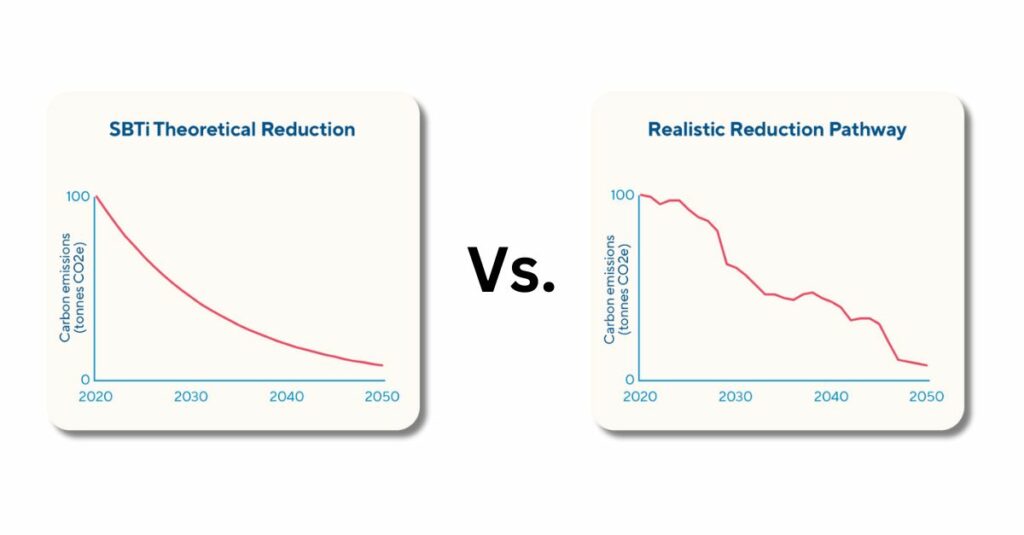Introduction
In recent months, we’ve seen quite a lot of turbulence in environmental commitments. Most notably, Rishi Sunak has made some significant U-turns on certain climate policies. But before this erupted there had been a dawning realisation amongst companies who have started to adapt or pivot on their Net Zero and sustainability commitments:
- Crocs have pushed their Net Zero target back from 2030 to 2040
- Amazon have had their ‘Commitment Removed’ from SBTi
- BP scale back their climate targets as their profits hit new records
- Lego shelves their plan for a recycled plastic alternative that have a higher carbon footprint
This is just a few examples of some of the leading brands shifting their targets. There’s another 100+ who have had their 2030 commitments removed from the SBTi and it is likely that there’ll be hundreds more examples like this moving forward. Net Zero is the pinnacle of decarbonisation goals, and if you’re serious about sustainability, it’s a ‘must have’ in company policy. We’ve seen this enthusiasm in recent years grow exponentially as the number of companies with Net Zero targets has more than doubled in 2.5 years. With so much initial enthusiasm, what is going on with these commitments now?
Off Track
It seems we are in a pivotal moment, where if we don’t rethink our position, we could end up in a serious mess. It’s now coming to light that lofty decarbonisation goals are unrealistic. They are often set with arbitrary targets based on theoretical actions and behaviours, which is not the best basis on which to head for Net Zero. Optimistically hoping for the best, buoyed up on good intentions and virtues is not a serious strategy – that’s what we are calling ‘greenwishing’.
We are finally being faced with a higher dose of reality. Some companies are digging into what is actually possible and they are starting to find some hard truths.

The truth is that setting a fixed carbon budget, or in the technical parlance ‘Absolute Contraction’, won’t work for 95% of businesses. This is the preferential route to Net Zero as outlined by the SBTi, and it’s based on 90% reduction in emissions by 2050. While this may be an admirable target in practice, we are now seeing that it is barely possible in reality. According to an Accenture report last year it’s believed that 93% will fail to achieve their goals unless they double the pace of emissions reduction by 2030. Our prediction is that only a small minority of organisations will achieve the required Net Zero reductions by 2030, regardless of their stated ambitions. We need to reconsider how we think about decarbonisation, and it starts with being more pragmatic when it comes to implementation.
Business Growth
The essence of all working economic models is growth. Growth is good. It means more jobs, more supply of the things we want and a higher quality of life. However, the current SBTi targets and structure aren’t conducive to normal business activity in the modern day. For example, when asked why they have pushed their commitments back Crocs explained that they had not completed the acquisition of HEYDUDE nor had it completed a comprehensive baseline of its greenhouse gas emissions when it first set its Net Zero target. Mergers and acquisition is a totally valid business activity that many growing companies will experience and it fundamentally effects carbon strategies, however, imagine setting out on an expedition without a map. This is the equivalent of what Crocs have done in not working out their baseline when setting their Net Zero target. This kind of behaviour should no longer be excused in the sustainability and ESG space.
Moreover, companies like UK-based Forest Carbon and Spain’s GRI Renewables are also amongst those who have had their ‘Commitment Removed’. These are the very companies that need to continue to innovate and grow to bring the much-needed technological advancements necessary to reach Net Zero. The catch here is that growth still means increasing total emissions, regardless of how beneficial that growth might be to the wider world and climate. So, how do we create a more accessible and inclusive framework for companies like this?
Dealing with Despondence
Intensity Metrics need to be embedded into the way we think about decarbonisation. Intensity Metrics take into account a company’s specific circumstances and challenges and focus on reducing emissions per unit of output. It’s a metric that is offered within SBTi, but it requires a 97% intensity reduction, is only allowed for Scope 3 emissions and is only for organisations over 500 employees. It’s as interesting as is staggering that this option has been excluded for those who need flexibility the most – the Small and Medium Enterprises, as defined as companies with less than 500 employees. Having a definition of acceptable decarbonisation that only a minority of companies can participate in will likely result in complacency and subsequent despondence, and as we’ve seen from even some of the biggest brands, delay and confusion.
Progress Over Perfection
This is not to advocate for laissez-faire decarbonisation strategies. It’s still important to aspire to an ultimate carbon reduction of 90%, but this can, and should be done based on the carbon intensity of the organisation. When implementing a detailed plan, it should be reviewed at least annually so that any inevitable technological advancements, economic cycles, or political changes can be taken into consideration. This might mean some years organisations will achieve a 2% emissions reduction but other years there will be commercial opportunities to achieve bigger leaps via the use of new processes and technologies. The point is businesses, like economics and geopolitics, don’t follow a rigid, linear path. To assume so is painfully naïve. We need to be able to adjust course as needed and acknowledge that the road will be bumpy and difficult. The important thing is getting organisations to do everything within their control, and have a clear, well-considered and technical strategy to reach Net Zero over the long run.

From Idealistic to Realistic
For those with the good fortune of being able to follow an Absolute Contraction or carbon budget methodology, they will be able revel in their fantastic achievement and hopefully they can share their lessons learned for the greater good. But for the remaining majority, if you can’t deliver a carbon budget it doesn’t mean you are failing. There is another way. Focusing on Intensity Metrics and encouraging ambitious year-on-year reductions will deliver far greater results over the longer term than setting an idealistic pathway to Net Zero that looks good on paper but cannot realistically be achieved. We want to engage those organisations who may feel unnerved by the scale of the challenge and discouraged by some of the definitions of success. We can assure you that there is a credible and positive way forward that all organisations can participate in, and collectively we can achieve our wider climate goals.
Chris Hocknell, Director
Chris brings over 18 years’ experience of supporting the built environment and corporate world with their sustainability goals. Specialising in sustainability strategy development, Chris works closely with clients to assess and understand their carbon and environmental footprint.






